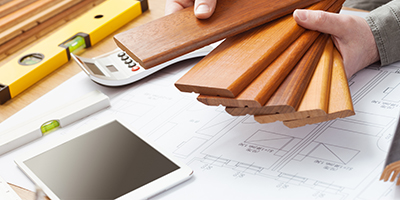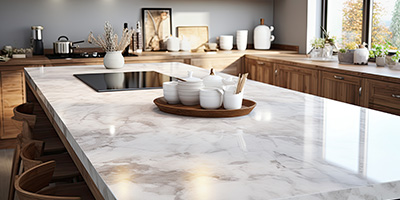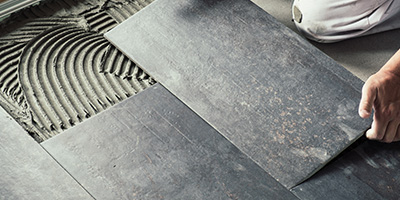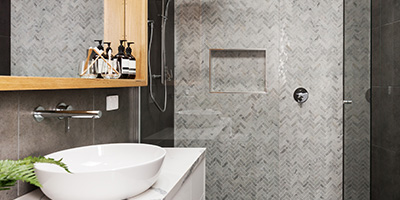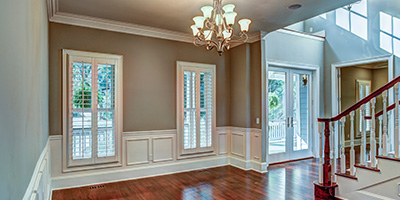A Complete Room-By-Room Aging in Place Checklist
Discover easy projects to make your home more comfortable and accessible for aging in place.

Simple Home Modifications to Make Aging in Place Possible
There’s nothing quite like the comfort of your own home. And as you or your parents enter the golden years, it’s hard not to see a room and have fond memories attached to it. That’s one of the big reasons that aging in place — staying at home instead of an assisted living facility or moving in with family — is an increasing trend.
However, sometimes the home’s design may not meet the standards for aging in place. Doorways may be too small for a walker or the bathroom floor might be too slippery. But with some slight remodeling and modifications, homes can easily be transformed for the elderly and disabled to allow for a comfortable living space.
With help from Danielle Arigoni, Director of Livable Communities for AARP, we'll walk you through the different details to keep in mind for your space.
Average Renovation Costs for Seniors
According to Arigoni, there’s not one solid number for how much it will cost to modify a home for aging in place. “It really depends on the home you currently live in, the location and the needs you may have."
The average price range is $24,550-$56,400. The breakdown for individual rooms is in the table below, but keep in mind that the cost can fluctuate with your specific wish list items.
Costs for Aging in Place Remodeling
Room | *Average Cost |
|---|---|
Kitchen | $15,000-$20,000 |
Bathroom | $2,500-$24,800 |
Bedroom | $1,350-$2,200 |
Hallways | $800-$1,400 |
Stairs | $400-$4,000 |
Don’t let the price tag of aging in place design overwhelm you. If time permits, you can take care of projects over the course of a year or two. Just remember that it’s never too early to start thinking about which projects to tackle first.

“Remodeling can be very expensive. If you consider future needs early, you can include improvements that will benefit you later in life any time you begin remodeling.”
Tips for Aging in Place Home Design
Ideally, a home that is ready for aging in place follows the principles of universal home design. The essential rooms of a home — kitchen, bathroom and bedroom — would be on one floor with rooms that feature an open floor plan for easy mobility, which may require knocking down a wall.

General Home Modification Tips
There are certain improvements that aren’t specific to one room but should be done in each area that it applies to, from the living room to the garage.
“Some basic changes can make a big impact on the safety and suitability of a home for people who might have trouble getting around,” Arigoni says. “Even small fixes like door handles and pull-chains on lights can make a difference.”
Aside from making sure that safety features, like smoke and carbon monoxide detectors, are working and that flashlights are in all the major rooms, here are the top precautions to take throughout the home:
☐ Change to lever-style door handles: Levers require less grip and strength to use.
☐ Remove throw rugs or add non-slip backing: Throw rugs can easily become a tripping hazard and skid when stepped on. If you can’t get rid of the rugs, add non-slip strips to reduce the risk of sliding or folding.
☐ Eliminate clutter: Remove unnecessary and rarely-used objects to cut down on trip hazards throughout the house and open space for better storage.
☐ Keep in-use cords tucked away from heavily-walked areas: Whether it’s a power cord for a TV or a phone charger, tuck them under a side table or behind the couch to make sure they are not in an area where people are walking.
☐ Install video monitoring: Most camera systems come with a smartphone app so you can check in on a loved one wherever you are. However, make sure you ask permission before getting started.
☐ Change lighting to bright, LED bulbs: Install bright, glare-free lighting to increase visibility throughout the home. While doing this, it may also be a good time to consider updating any pull-chains that aren’t sturdy enough.
☐ Install light switches on both ends of rooms and hallways: The extra switches ensure that no one has to walk in the dark.
☐ Put double-handrails on all staircases: A place to grasp on both sides of a staircase increases stability.
☐ Ensure a five-by-five foot turning space: If a wheelchair or walker becomes necessary for mobility, the National Association of Home Builders recommends this as a minimum to make sure turning is possible without interference in areas like the living room.
☐ Widen doorways to a minimum of 36 inches: AARP recommends doorways be widened to make them comfortable for a wheelchair to pass through.
☐ Get a digital thermostat with big numbers: With push buttons and a large display, a digital thermostat is an easy home modification to help keep a comfortable home temperature.

“Beyond just having a place for yourself to age, it is also beneficial to think about those who might visit you or possibly live with you in the future.”

Key Entrance and Garage Updates
If there’s a place to start aging in place modification, Arigoni says it’s the entryway to a home. Why? Because it is the portal to your home for not only you, but anyone who might be visiting. Making sure it is safe, both inside and outside of your doorway, is not only a key facet of aging in place but also of universal home design and the proper updates will make sure that your home is accessible to anyone who may come to visit. Here are the home improvement projects that will have the biggest impact:
☐ Remove stairs from outdoor entries or add handrails: Ideally, the main entrance to a home will have no stairs leading to it. If that’s not possible, make sure they are sturdy and feature strong handrails for added stability.
☐ Install a ramp: Ramps are needed for wheelchair access, but can also be great options for those who use walkers or have mobility issues. Just be sure to follow the Americans with Disabilities Act Guidelines to make the ramp with a minimum of six inches of length for each inch of rise.
☐ Get a motion sensor light at main doors: A brightly lit outdoor entryway will help reduce trips and other vision-related issues.
☐ Build or purchase a covered carport if there is no garage: Everyone needs to leave the house from time-to-time. A covered area to park ensures a weatherproof place for entering and exiting the vehicle.
☐ Install big, easy-to-read house numbers: In the event of an emergency situation, large address numbers above the front door or garage will make it easier for help to find the house quickly.
☐ Get a surface to place packages and bags when opening the door: A simple purchase of a table that is waist high both inside and outside the main door makes it easier to carry items inside.
☐ Install non-slip flooring in the foyer: The foyer is a tricky place, from the possibility of wet floors to changing shoes. Non-slip flooring helps decrease falling possibilities by keeping traction no matter the circumstances.

“Creating a zero-step entry and widening doorways and hallways can help not only yourself as you age, but anyone who might visit you. Another bonus is that it helps you when you need to move large furniture or when you have a handful of groceries to bring in.”

Aging in Place Bathroom Design
The bathroom is one of the most important and frequently updated rooms because of the number of slippery surfaces. Plus, with plenty of items hanging off the wall, like vanities, towels rack or mirrors, the space available in a typical bathroom can get tight. Luckily, bathroom modifications are some of the easier ones to make and it’s possible to make the room much safer with a few updates:
☐ Install grab bars near the toilet, bath and shower: These should be bolted into a wall and able to support up to 300 pounds.
☐ Install a shower seat: The option to sit in the shower decreases the likelihood of slipping. It can either be a permanent seat or a stool that suctions to the floor.
☐ Raise toilet seat height to 17-19 inches: Raising the height makes it easier for those who struggle to sit or stand.
☐ Change sink handles to levers: Similar to door knobs, lever sink handles are easier to use.
☐ Add anti-slip coating to the tub and shower: Either non-slip adhesive strips or a bath mat will help provide traction for feet while washing.
☐ Get a slip-resistant floor treatment: Slip-resistant bath mats with a rubber backing can be placed by the tub, sink and toilet. For a longer-term solution, consider replacing the floor with rubber or no-slip vinyl.
☐ Install a handheld showerhead: According to Arigoni, installing a handheld, adjustable-height showerhead is one of the easiest DIY aging in place design projects because of the low price and simple installation.
☐ Change to a no-curb shower or walk-in tub: Stepping over the edge of a tub can be dangerous. Eliminate that risk by converting your tub into a no-curb shower or installing a walk-in bathtub.
☐ Add a light above the bathing area: Better lighting is a staple of aging in place modification, even in the bathroom. Having a light in the bath or shower itself will increase visibility.
☐ Ensure doors open outward to maximize space: When a door opens into the bathroom, it takes away valuable space for maneuvering with wheelchairs or walkers.

Kitchen Design for Aging in Place
The kitchen can be one of the most difficult rooms to update, mostly because so many adjustments are built into the room. Arigoni suggests thinking about how you can update the kitchen for future use any time you make a modification in the room, whether that be for aging in place or for young children to gain independence.
“If you are renovating your kitchen, think about incorporating lower-level, pull out drawers for dish and glassware storage, which make it easier for young kids to reach supplies — and for adults in wheelchairs, too,” Arigoni says.
Here are the top improvements to consider in the kitchen:
☐ Get a hands-free faucet or switch to lever handles: If you don’t want a faucet that starts and stops with just a touch, switch to levers for easy use.
☐ Switch to an electric stove with front-mounted controls: Flat-top electric stoves eliminate the chances of leaving the gas on while controls mounted on the front decrease accidental burns and are easier to reach for people in wheelchairs.
☐ Buy a fire extinguisher and make it accessible: Keep an extinguisher handy in the case of a fire. Smaller, lighter models designed similar to a spray bottle work best for the elderly.
☐ Add roll-out trays to base cabinets: Trays that can be pulled out reduce the amount of bending needed and make items easier to find.
☐ Rearrange cabinets so most-accessed items are easy-to-reach: Keep items that are often used located between eye and knee level to avoid accidents or dropping items due to reaching and bending.
☐ Buy a refrigerator with accessible storage: Door storage and a side-by-side design helps make items more visible and reduces bending.
☐ Move microwave to counter height: Recent home designs have the microwave hanging over the oven, which requires reaching and is not accessible for people in wheelchairs. Move them to the countertops for easy use.
☐ Install Lazy Susans for corner cabinets: Allows for ease of access to items in corner cabinets.
☐ Mount under-cabinet lighting: For added visibility in dark areas, lights can be wired to a switch or a battery-powered, push-button LED mounted to the frame.
☐ Adjust sink and counter height: A height of 36 inches is the standard for countertops, but some houses opt for a bar-height of 42 inches. Additionally, while 36 inches is functional for all, the American with Disabilities act recommends countertops be 28-34 inches above the floor.

Important Bedroom Modifications
When mobility is an issue, getting in and out of bed each day can be a problem. But even if you or a loved one is still moving fine, there are still other safety issues that are quick to fix. From getting the proper bed to making sure that lighting is ample, here’s how to prepare the bedroom for aging in place:
☐ Get a low-profile bed: AgingInPlace.com suggests a 20-23-inch height for beds because it presents the best leverage for getting in and out of the bed. Another option is an adjustable mattress that folds up and down with a remote control.
☐ Install a light near the bed: The goal is to minimize walking in the dark. Flipping a switch once comfortably in bed is the ideal solution, but a bright nightlight that shows the path to the bed works too.
☐ Buy a nightstand that is the same height as the bed: Reaching down to grab something off a low nightstand could lead to a fall, while a nightstand that is too tall can obstruct mobility to and from the bed.
☐ Install a bed rail: A rail provides something to grab while getting in and out of bed for added support and stability.
☐ Add lighting to closets: Lighting in closets helps to locate items, leading to less digging around and potential falling items.
☐ Maintain adequate clearance around the bed: Keep the area around the bed clear so that anyone using a wheelchair or walker can get right to the edge.
☐ Have a phone beside the bed: Whether it’s a landline or a cell phone, keep one beside the bed in case of emergency.

Pro Tip
If you’re DIY savvy, some of these projects might not require a contractor. However, some might call for professional help. Check out our guide on DIY vs. Pro projects if you are unsure.
Home Is Where the Heart Is
Whether you go above and beyond the items in this checklist or pick and choose the items best for you, make sure you have a remodeling plan in place in a way that fits you and your loved ones. After all, safety is at the heart of the matter.
Even if it's safer for you to find a different living situation with these accommodations already finished, we've got plenty of tips to help you through the downsizing and moving process.
Our aging in place checklist highlights to top modifications to make in the main rooms of your home to ensure that you or a loved one can stay safe while living at home.
Other Sources
Average Renovation Cost Estimates. (2019, June 11). Retrieved from Fixr and Retirement Living
Expert Contributors

Danielle Arigoni
Danielle worked as AARP's Director of Livable Communities for five years, advocating for national efforts that could assist communities of older adults. Currently, she works as Managing Director of Policy and Solutions at National Housing Trust in Arlington, VA and published a book discussing the impacts of climate change on the older population.
What Do You Think?
Do you have thoughts on renovations for aging in place? We're listening. Head over to Twitter or Facebook,
and use #dumpstersblog to join the conversation.



